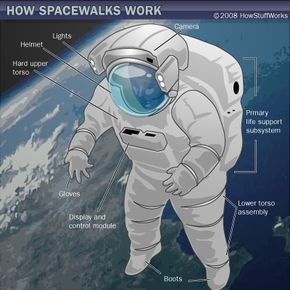Spacewalks and Space Suits
The current space suit design used by astronauts aboard the International Space Station is a result of more than 60 years of innovation. Space suits have their own technical term used by NASA officials: extravehicular mobility unit (EMU). Astronauts actually refer to a space suit as a minivehicle or vessel, not just a suit -- it does, in fact, weigh over 240 pounds (108.9 kilograms) on Earth.
This first thing you'd notice after putting on a space suit before going on a spacewalk is that the suit is very bulky. Although NASA is constantly working to make suits slimmer and more ergonomic, they have to be quite hefty by nature because that provides the necessary pressure to survive in a vacuum. An EMU actually has an impressive total of 14 layers that combine to offer heating, cooling and a pressurized system. The first three consist of the liquid-cooling-and-ventilation garment (LCVG), which is essentially like long underwear made of nylon and spandex. It's laced with tiny plastic tubing for cooling purposes and gas connectors for ventilation. Above that is a pressure garment bladder, an inflated layer of urethane-coated nylon that provides pressure, followed by a pressure restraint called Dacron. The final nine layers consist of the thermal micrometeoroid garment, which is made of a multilayered aluminized fabric called Mylar that protects astronauts from penetrating objects. This doesn't even count the Maximum Absorption Garment (MAG), which is the very first piece of clothing astronauts put on. It's essentially an adult diaper that collects an astronaut's urine -- an EVA may last for as long as seven hours, and you never know when nature will call in the void of space.
Advertisement
There are, along with the LCVG and MAG, 18 separate pieces to a space suit, including the Primary Life-Support System (PLSS), a backpack unit that provides astronauts with oxygen, carbon-dioxide removal, electrical power, a water-cooling system and communication, a Displays and Control Module (DCM) and a helmet and visor. Putting on a space suit, despite its many parts, is actually a fairly quick process -- astronauts can put everything together in about 15 minutes. The process a spacewalker must undertake before leaving the protection of a spacecraft actually takes longer. To learn about spacewalk procedure and preparation, read the next page.
